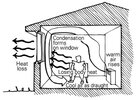CT clamps measure current not power.
Don't need to know current for the oven, what is needed is time, I can look in the over manual to get power used by rear, side, and top elements, the fan is not enough to worry about, but I need to measure the time each element is used for, and without a cooker sized energy meter which would need hard wiring in, can't really measure the time, well I suppose could rig some thing up to record how long the red lamp is on for with oven, but the times are far too short to measure with the hob, and your comment about power factor is likely valid for the induction hob.
Because the air being cooled by the window convects down, and the air being warmed by the rad convects up, the two meet at around windowsill area and mix, funnelling out into the room.
I have two diagrams


not sure I agree with either, since my house living room two radiators at 90° to each other, but the comment pre-double glazing is valid, as I remember my first house, gas hot air central heating, warmed the house fast, but also cost a lot, because the fan moved the air around so no cold or hot spots, but noted first with mothers house, within her living room recorded in winter at same point of time 16°C and 24°C in her case it was down to bay windows catching the sun, but today in my living room 2 x TRV heads and a baby alarm all showing in my bedroom the living room temperature, 17°C, 18°C and 16°C some days there is more of a difference within the same room. All recorded low down, and this is a problem as the body hight temperature is much higher, my hall is often showing even more now showing at TRV 16°C and at Nest Gen 3 18.5°C the warmer the day, the less the difference, and showing 13.4°C outside at the moment.
There must be air movement possible as the diagrams show, but with such varying temperatures within the room, this must be very slow. In the old days, the cold air entered the room under the door, and hot air left up the chimney, I did see one house with vents by the fire so combustion air was drawn into the room local to the fire, but this was not very common.
Today we have extractor fans over the cooker, but no ducted air from outside to replace it, and as said any electric power used, ends up as heat in the home anyway, the largest loss of energy is likely the gas cooker, as one needs extractor fans with the gas cooker to remove the waste products from burning gas, in the main water, with electric we only run the fan on a hot day to remove the heat, and since induction hobs put less heat into the room, not needed much.
I have plug in monitors, three in all, and I have tested most plug in devices, plus a meter which does whole house, provided years ago by Scottish power, but that meter too general and the CT is too big to fit inside consumer unit, and the others only work with plug in devices.
So alerted to a fault freezer, and also realised how much a Sky box costs as it powers the LNB 24/7 to pick up program changes, and I use them to see when the car battery has finished charging and if my home brew is reaching set temperature, but in the main they are toys, one even records the power factor, but what is the point in it all.
Simple fact, if I don't need the device unplug it, and if I do need the device, I am going to use it however much it uses.
I will look at one item the fridge/freezer, when new we are told the annual energy consumption, around 250 kWh, so divide that by 365 and we have 684 Wh per day, the manufacturer always seems to under estimate what it will use, so 700 Wh per day is around what we expect. So we stick the energy meter on it, and it shows 800 Wh per day, so what are you going to do? To re-gas will likely cost £100, and it may not be short of gas, the insulation may have started to fail, so costing 36.5 kWh per year more than it should, so what is that in money? Around £10 so not worth doing anything.
Now at 1560 Wh per day, that's more of a worry, motor when running used 65 watt, so clearly not turning off, so is the unit needing serious work, or is it simply the thermostat failed, so next step is measure the freezer temperature, if -18°C or higher some thing wrong with gas or insulation, if however -24°C it is not regulating temperature.
But where do you find a thermometer to check it with? Well -18°C is freezing point of brine, so mix some salt and water heat it so sure saturated, then put it in freezer and see if it freezes, if it does likely thermostat problem.
So I have shown one use for the energy monitor, but would it not be far easier to buy a thermometer instead, or just try freezing brine? So as said the energy meter is a toy.



